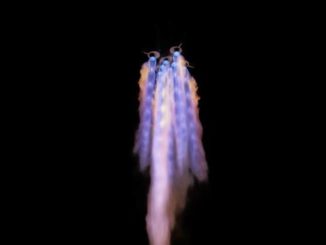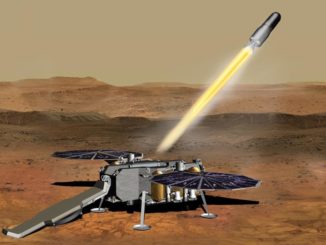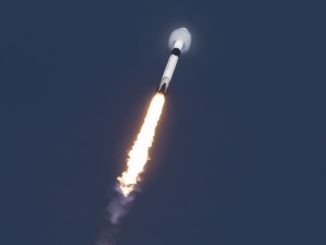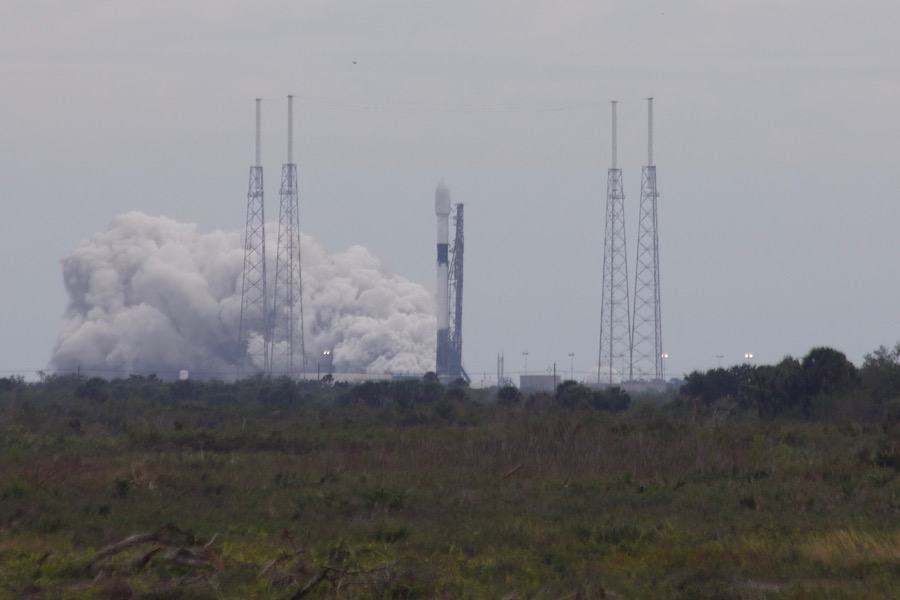
SpaceX test-fired a Falcon 9 rocket Saturday at Cape Canaveral, two days before a scheduled launch Monday with 60 Starlink broadband relay stations that will make SpaceX the owner of the world’s largest fleet of commercial satellites.
With the 60 satellites set for launch Monday, SpaceX will have delivered 180 signal relay stations to orbit for the company’s Starlink Internet network.
That will make SpaceX the owner of more commercial satellites than any other company, exceeding the record set by San Francisco-based Planet, which operates a constellation of small Earth-observing satellites.
A Planet spokesperson said in November the company had roughly 120 operational nanosatellites in its fleet. Planet has launched an additional 20 larger SkySat and RapidEye Earth-imaging spacecraft, bringing its entire fleet size to no more than around 140 satellites.
With around 75 operational satellites, SES owns the third-most spacecraft currently in commercial service, and has the biggest fleet of large commercial broadcast and broadband satellites in geostationary orbit. Iridium has 70 of its new-generation voice and data relay satellites in operational service or filling backup roles.
SpaceX’s Starlink satellites have a flat-panel design and each weigh about a quarter-ton, significantly smaller than the spacecraft owned by SES and Iridium. But SpaceX aims to launch thousands of Starlink spacecraft in the coming years to provide global Internet service, creating a mesh-like network around the globe rather than relying on a smaller number of higher-power satellites like traditional geostationary satellite operators.
The launch of the 60 newest Starlink satellites Monday night is set for 9:19 p.m. EST, or 0219 GMT Tuesday, using a Falcon 9 rocket first stage that has been launched and recovered on three previous missions.
There is a greater than 90 percent chance of acceptable weather at Cape Canaveral for launch Monday night, according to the official launch forecast.
The 229-foot-tall (70-meter) Falcon 9 rocket lit its nine Merlin 1D first stage engines Saturday at 12 p.m. EST (1700 GMT) in a customary pre-flight test-firing at Cape Canaveral’s Complex 40 launch pad.
In a break from SpaceX’s standard practice during Falcon 9 test-firings, the 60 Starlink satellites are already mounted on top of the launcher inside the rocket’s payload fairing. Since a Falcon 9 rocket exploded during a pre-flight test-firing in 2016, destroying an Israeli communications satellite, SpaceX has typically performed the static fire tests without the rocket’s payload on-board.
That practice could change for future Starlink missions, for which SpaceX is both the launch provider and the payload owner.
The Falcon 9’s nine kerosene-fueled Merlin 1D main engines fired for several seconds at pad 40 Saturday, ramping up to full power with 1.7 million pounds of thrust as hold-down clamps kept the launcher firmly on the ground.
SpaceX confirmed a successful static fire test in a tweet Saturday afternoon, and announced that the mission launching Monday will reuse a Falcon 9 booster that previously flew on three missions.
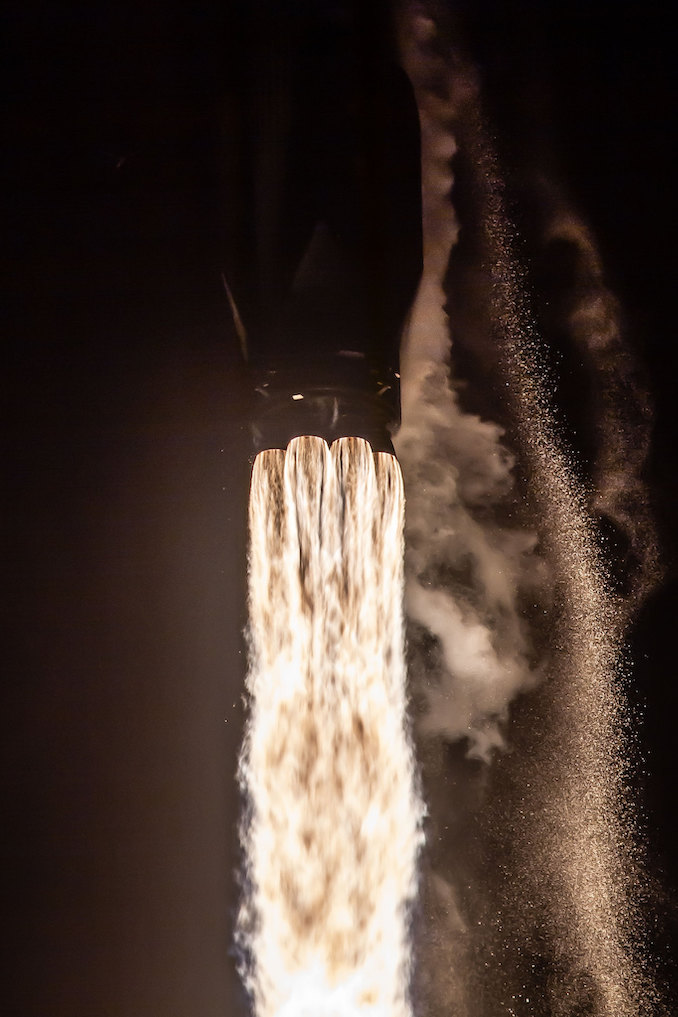
The booster debuted in September 2018 with the launch of the Telstar 18 VANTAGE communications satellite from Cape Canaveral, propelling the Falcon 9’s second stage with the hefty spacecraft toward orbit, then landing aboard SpaceX’s drone ship in the Atlantic Ocean.
The first stage flew again in January 2019 from Vandenberg Air Force Base in California with 10 Iridium voice and data relay satellites, and again landed on a drone ship at sea.
Most recently, the booster launched SpaceX’s first batch of 60 broadband satellites from Cape Canaveral in May 2019. After landing for the third time on a SpaceX recovery vessel, the stage was refurbished and readied for its fourth mission set to take off Monday.
SpaceX plans to recover the Falcon 9’s first stage again after Monday night’s launch, along with the rocket’s payload fairing. The company’s rocket recovery vessels were dispatched from Port Canaveral to head toward the landing zones in the Atlantic Ocean.
It will take about an hour for the Falcon 9 rocket to deliver the 60 Starlink satellites to orbit a couple hundred miles above Earth.
The Falcon 9 will head northeast from its launch pad at Cape Canaveral, separate its first stage and payload shroud a few minutes after liftoff, then fire its upper stage engine two times to inject the Starlink payloads into orbit.
Retention rods holding the Starlink satellites to the rocket will release to allow the spacecraft to separate from the Falcon 9’s upper stage all together. Once uncoupled from the rocket, the satellites will gradually spread out while they begin activating their krypton ion thrusters to begin raising their orbits for testing, eventually targeting an operational altitude of 341 miles (550 kilometers) at an orbital inclination of 53 degrees to the equator.
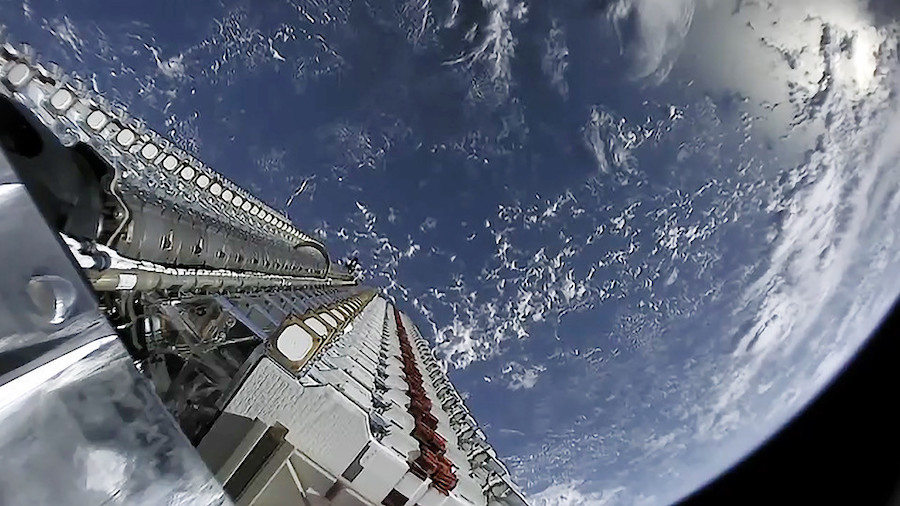
The launch Monday will kick off a brisk pace of launches by SpaceX planned for 2020.
Gwynne Shotwell, SpaceX’s president and chief operating officer, said last month the company could perform as many as 35 to 38 launches this year from three launch pads in Florida and California. That figure does not include potential test flights of SpaceX’s next-generation Starship vehicle.
The bulk of SpaceX’s missions in 2020 will add satellites to the company’s Starlink constellation of broadband satellites. SpaceX has said two additional Starlink launches could take off from Cape Canaveral before the end of January, following Monday’s mission.
SpaceX plans to operate the initial block of 1,584 Starlink satellites in orbits 341 miles above Earth. The company has regulatory approval from the Federal Communications Commission to eventually field a fleet of up to 12,000 small Starlink broadband stations, and has hinted in additional regulatory filings that it could seek to operate up to 42,000 Starlink spacecraft.
In response to concerns from astronomers, Shotwell said one of the 60 satellites set for launch Monday will test a new less-reflective coating designed to reduce the brightness of the spacecraft. The first 120 satellites were brighter than expected, raising worries from scientists that thousands oof Starlink craft could interfere with astronomical observations.
The company says it hopes to begin regional broadband service with the partially-complete Starlink constellation by the middle of this year, once it has launched 12 Starlink missions. Starlink service for Internet consumers worldwide will come after 24 launches, according to Shotwell.
SpaceX has not announced pricing for the Starlink service.
“All I know is you will be far happier with the value of the Starlink service than you are with your current service,” Shotwell said in December. “You will, for sure, get way more bandwidth for the same price, or way more bandwidth for less … You’ll be far happier with this. The value will be far greater (than with current Internet service providers).”
She said SpaceX is building about seven Starlink satellites per day at a factory in Redmond, Washington. Low-volume production of SpaceX’s ground user terminals is also underway in California, Shotwell said.
SpaceX is still working out its strategy for commencing Starlink commercial services.
“Between now and June … we’re going to have to figure that out,” Shotwell said. “We will do presales like Tesla has done. The initial experience will be bumpy. We’ll have early customers be part of that journey with us. We’re not going to fib and say it’s going to be the best thing ever. When you get service, it’s going to be great. But it will be bumpy for a while.
The U.S. military has a contract with SpaceX to demonstrate the Starlink network’s ability to deliver data to the cockpit of airplanes, the first of what SpaceX hopes will be a lucrative business selling bandwidth to the Defense Department.
“I think we probably will mature as a provider, and it should not be bumpy, really in ’21. By ’21, I think we probably will have figured out most of the problems.”
Email the author.
Follow Stephen Clark on Twitter: @StephenClark1.

